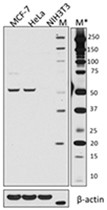- Clone
- W16038A (See other available formats)
- Regulatory Status
- RUO
- Other Names
- Recombining binding protein suppressor of hairless, CBF-1, Jκ-recombination signal-binding protein, IGKJRB, RBP-Jκ (RBPJK), Renal carcinoma antigen NY-REN-30, RBPSUH, recombination signal-binding protein Jκ
- Isotype
- Rat IgG2a, κ
- Ave. Rating
- Submit a Review
- Product Citations
- publications

-

Total cell lysates (15µg protein) from MCF-7, HeLa, NIH3T3 were resolved by 4-12% Bis-tris gel electrophoresis, transferred to nitrocellulose, and probed with 1µg/mL purified anti-RBPJ (clone W16038A) antibody. Proteins were visualized using a goat anti-rat-IgG secondary antibody conjugated to HRP and chemiluminescence detection. Direct-Blot™ HRP anti-β-actin (clone 2F1-1) antibody was used as a loading control. M*: protein standards with longer exposure time.
| Cat # | Size | Price | Quantity Check Availability | Save | ||
|---|---|---|---|---|---|---|
Recombination signal-binding protein Jκ (RBPJ), also known as CBF-1, is a member of CSL family of transcription factors. RBPJ is the vertebrate ortholog of the Drosophila gene Suppressor of Hairless and is a highly conserved DNA-binding protein that mediates canonical Notch signaling. RBPJ is ubiquitously expressed and acts as a transcriptional repressor in the absence of Notch signaling. After ligand binding, Notch signaling is initiated by proteolytic cleavage and release of the active Notch intracellular domain (NICD). When it binds to the activated and nuclear-localized NICD, RBPJ recruits transcriptional coactivators and induces the activation of target genes containing consensus RBPJ-binding sequence C(T)GTGGGAA. RBPJ has been reported to be crucial in the cell fate determinations and regulation of cell proliferation and differentiation.
Product DetailsProduct Details
- Verified Reactivity
- Human
- Antibody Type
- Monoclonal
- Host Species
- Rat
- Immunogen
- Partial human RBPJ recombinant protein (101-350 a.a.) expressed in E. coli.
- Formulation
- Phosphate-buffered solution, pH 7.2, containing 0.09% sodium azide.
- Preparation
- The antibody was purified by affinity chromatography.
- Concentration
- 0.5 mg/ml
- Storage & Handling
- The antibody solution should be stored undiluted between 2°C and 8°C.
- Application
-
WB - Quality tested
- Recommended Usage
-
For Western blotting, the suggested use of this reagent is 0.2 - 1.0 µg per ml. It is recommended that the reagent be titrated for optimal performance for each application.
- Application Notes
-
Clone W16038A does not cross-react with mouse (in-house tested).
Antigen Details
- Structure
- 500 amino acids with a predicted molecular weight of 55.6 kD. Contains a IPT/TIG (Ig-like, plexins, transcription factors) domain that is involved in DNA-binding.
- Distribution
-
Nucleus and cytoplasm.
- Function
- Transcriptional regulator that plays a central role in Notch signaling, a signaling pathway involved in cell-cell communication that regulates a broad spectrum of cell-fate determinations.
- Interaction
- Interacts with activated NOTCH1, NOTCH2, or NOTCH3. Interacts with HDAC1, HDAC2, NCOR2, SAP30, FHL1/KYOT2, CIR1, EP300, MAML1, PTF1A, EBNA2, EBNA3, EBNA4, EBNA6, RITA1/C12orf52, CHCHD2, CXXC5, BEND6, NKAPL.
- Antigen References
-
1. Meyer Zu Horste G, et al. 2016. Cell Rep. 16:392.
2. Nielsen CM, et al. 2014. Development. 141:3782.
3. Zhang S, et al. 2014. Cell Res. 24:925.
4. Wang H, et al. 2014. Proc. Natl. Acad. Sci. USA. 111:705.
5. Castel D, et al. 2013. Genes Dev. 27:1059.
6. Shi M, et al. 2012. J. Cell Sci. 125:4320. - Gene ID
- 3516 View all products for this Gene ID
- Specificity (DOES NOT SHOW ON TDS):
- RBPJ
- Specificity Alt (DOES NOT SHOW ON TDS):
- RBPJ
- App Abbreviation (DOES NOT SHOW ON TDS):
- WB
- UniProt
- View information about RBPJ on UniProt.org
Related Pages & Pathways
Pages
Related FAQs
Compare Data Across All Formats
This data display is provided for general comparisons between formats.
Your actual data may vary due to variations in samples, target cells, instruments and their settings, staining conditions, and other factors.
If you need assistance with selecting the best format contact our expert technical support team.
 Login/Register
Login/Register 







Follow Us